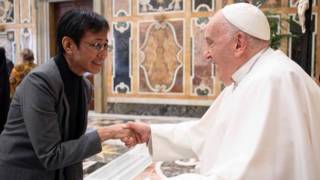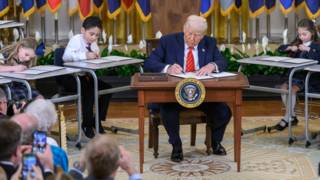
Guests
- Rashid MasharawiDirector, “Live from Palestine,” a documentary on the Voice of Palestine radio station.
Hearings begin today on the collapse of Enron Corporation, one of the largest bankruptcies in the history of U.S.business. In the latest stunning twist of the Enron drama, Ken Lay, former darling of the energy industry, resignedas chairman and chief executive to the corporation yesterday.
Lay’s resignation comes after a string of recent revelations have raised questions about the conduct of top Enronexecutives, including Lay himself. Disclosures by Congressional investigators have shown that Lay helped create andoversee some of the financial arrangements that helped lead to Enron’s collapse.
Scores of people who worked at Arthur Andersen’s Houston office were involved in the destruction of documents relatedto the Enron Corporation, according to the chairman of one of the Congressional subcommittees that will beginhearings on Enron’s collapse.
On Tuesday FBI agents moved into Enron’s headquarters to investigate charges of widespread shredding of corporatedocuments. The company’s auditing firm, Arthur Andersen, had already been caught destroying critical files, but thiswas the first sign that Enron had organized a similar operation. Representative James Greenwood, head of the HouseEnergy and Commerce oversight subcommittee, revealed today that that up to 80 people had received orders to destroypapers, calling into question Andersen’s attempts to blame rogue employees for the episode. Document destruction atboth companies will be a key focus of today’s Capitol Hill hearings. It is believed that each was shredding evidencewell into last week, long after government investigations had begun.
BRIEF HISTORY:
In 2001, Enron, a 15 year-old energy-trading corporation, was ranked number seven of the Fortune 500. But in December2001, Enron laid off 4,000 employees and became the largest company ever filing for bankruptcy. Many employees lost70 to 90 percent of their retirement savings as they were forced to hold their shares while Enron’s value plummetedto pennies per share. When criticism began to surface about its accounting practices, Enron management ordered itslaw firm to run a limited investigation, not to include “second-guessing,” which resulted in an October reportfinding no wrong doing at Enron or Arthur Andersen, auditor and management advisory services firm. Andersen stood byits reports until shortly before Enron failed, when Enron decided that four years of earnings had to be restated and$600 million–or 20% — of reported profits had to be erased. Andersen shredded thousands of paper and emaildocuments pertaining to Enron audits.
Guests:
- Andrew Wheat, Research Director, Texans for Public Justice.
- Abhay Mehta, author of “Power Play: A Study of the Enron Project.” Abhay Mehta trained as a MolecularBiologist from the Massachusetts Institute of Technology and Brandeis University. He returned to India in 1993, andbecame interested in the economics of the Enron-Dhabol Power project. He wrote Power Play about the entire project.
- Theresa Amato, President, Citizenworks. Theresa Amato was the national campaign manager for the Nader 2000presidential campaign on the Green Party ticket and is the founder and former executive director (1993-2000) of theCitizen Advocacy Center in Illinois.
- Bill Allison, Center for Public Integrity.
Related link:












Media Options